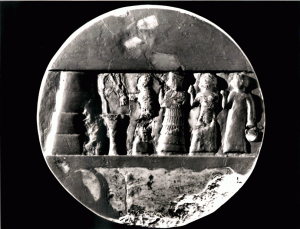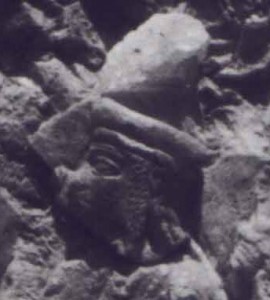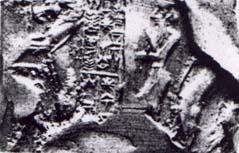www.angelfire.com/mi/enheduanna/Enhedvisual.html
(Texts: All Artifacts, Color Coding, & Writings in Bold Type With Italics Inside Parenthesis, are Added by Editor R. Brown, not the Authors, Translators, or Publishers!)
(gods in blue …mixed-breed demigods in teal…)
-
-
1)The Alabaster Disk: Restored and Unrestored
2)The Inscription on the back of the Disk
3)Three Cylinder Seals
-
The relief depicts Enheduana, standing behind a nude priest who is pouring a libation over a plant stand in front of a stepped structure. She is raising her right hand. This hand gesture can be found on most ritual scenes involving a deity. It has been coined “touching the nose” and is a gesture of deep devotion. [This reference can be investigated in Mayer Gruber’s dissertation]
In this restored version of the disk she is wearing a cap over her braids, however,
in the unrestored version (photo below ) she is wearing a high conical hat-reminiscent of the high polos hats of the priestesses of Mari.
To the right of Enheduana stands a priestess holding up a stick or wand and a priestess carrying a handled jug or ritual basketas mentioned in line 68 of nin-me-sara.
The translucent, white alabaster disk was discovered in 1926 by Sir Leonard Woolley. The inscription on the back alerted the world of Enheduanna’s existence. The disk was found in several pieces; this heavily restored version can be seen at the University Museum in Philadelphia. The disk was intentionally defaced in antiquity but that must have happened after 1900 B.C. as an Old Babylonian tablet copy of the inscription has also been found in its entirety.
The Inscription on the back of the disk
This inscription has been updated here with Dr. Joan Westenholz’s input. In the inscription a raised small d appears which I can’t reproduce here, so she has suggested I write out the word “dingir” which is what the small d represents in Sumerian philological notation. “Dingir” is a divine determinative found before the name of a god or goddess. Here it appears before Nanna’s (Nannar) name to indicate that Nanna the Moon God is being referred to rather than the moon, which is also called “nanna“.
I am not able to reproduce some of the other notations, so for a more accurate rendition, please see Frayne, 1993.
Here are the first 4 lines of cuneiform.
1) en-h[é]-du-an-na………………………En-h[é]du-ana,
2) MUNUS.NUNUZ.ZI. dingir NANNA……zirru priestess of Nanna
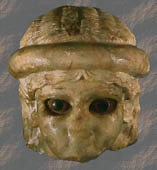 (brown-eyed beauty Ningal, spouse to Nannar, mother to Inanna)
(brown-eyed beauty Ningal, spouse to Nannar, mother to Inanna)
3) dam-dingir nanna………………………… wife of the god Nanna,
4) dumu-…………………………………………child
The inscription continues:
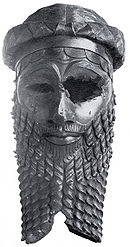
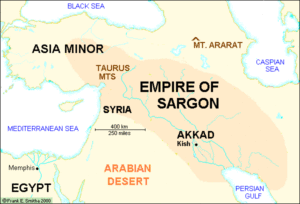 (Sargon the Great, King of Akkad, spouse to Inanna)
(Sargon the Great, King of Akkad, spouse to Inanna)
5) [´sar-ru]-GI………………………. of Sargon,
6) [ lugal]-…………………………. [king] of
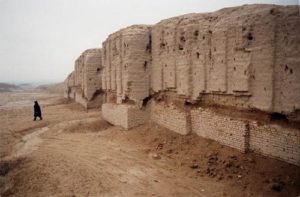 (wall ruins of Kish, Ninhursag‘s patron city)
(wall ruins of Kish, Ninhursag‘s patron city)
7) [KIS]…………………………….. the world (Kish),
8) [é-dingir INAN]NA.ZA.ZA………………… in [the temple of the goddess Inan]na– ZA.ZA
9) [ur]i.KI-ma-ka…………………. in [U]r,
10) [bara]-si-ga…………………… made a [soc]le (and)
11) [b]í-e-dù
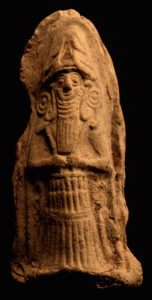
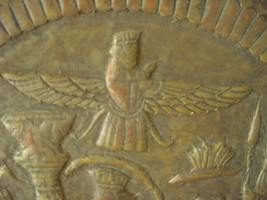 (Anu, King of planet Nibiru & Earth Colony, father in heaven to sons of god running Earth)
(Anu, King of planet Nibiru & Earth Colony, father in heaven to sons of god running Earth)
12) bára bansur-an-na………..named it: ‘dais, table of the god An (Anu) (or heaven)’
13) mu-sè bi-sa
Seal #1: Adda, Enheduana’s major- domo
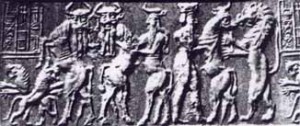 (Bull of Heaven, Enkidu, & Gilgamesh)
(Bull of Heaven, Enkidu, & Gilgamesh)
This seal belonged to Enheduana’s major domo, estate supervisor– perhaps her “right-hand man”. It depicts a bull attacked by a lion and a typical Kish hero armed with dagger. Enkidu, dagger in hand, and a bison. A second bison rampant. This is a mythological animal (Bull of Heaven) with the human face, splendid beard, and triple belt of Enkidu. The cartouche two small crossed lions. The Kish hero is a landmark in art. His flat cap, long hair and beard, and embroidered loin- cloth are here connected with the Sargonid period, but he is found before the time of Sargon, and is more properly traced back to the Pre-Akkadian school of Kish. The composition is simple and strong. Each figure is drawn separately on an open field.
——————–Legrain, Archaic Seals Impressions, UET vol III, p.358
The inscription reads as follows:
1) ad-da………………………… Adda (Adad, Nannar‘s younger brother),
2) ugula-é/sábra…………… estate supervisor/majordomo
3) en-hé-du-an-na………….of En-hedu-ana
The seal is made of black and white diorite and bears the excavation no.U 9178. It measures 3.7cm in length with its copper caps. It was found loose in the soil of the Royal Cemetary at Ur at a depth of about 3.4m. [Frayne,1993]
Seal #2: X-kitus-du, Enheduana’s scribe :
The seal depicts buffalo under a cartouche, and two crossed bulls. The water- buffalo with slanting lines on his horns is another landmark in art of the Sargonid period. The seal was rolled on sides and back and the complete scene (not shown here) showed the bulls attacked by the lion and the Kish hero. [Legrain, Archaic Seals Impressions, UET vol III, p.358]
The seal impression was found on a sealing, not the cylinder seal itself. It has the excavation no U 11684. The piece, which measures 4.2×2.5×2 cm, was found loose in the upper soil of the Royal Cemetary at Ur. [Frayne, 1993]
The inscription reads:
1) [en]-hé-[du]-[an]-na…………………[En]-he[du]-ana
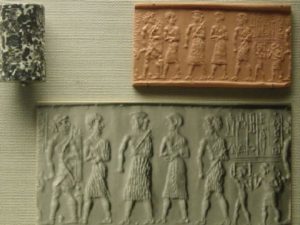 (King Sargon & associates of Akkadia)
(King Sargon & associates of Akkadia)
2) [dumu-´sa]r-ru-GI……………….. child of Sargon
3) [x]-ki-tus-du……………………………..[x]-kitus-du,
4) [dub-s]ar……………………………………[scri]be, (is) [h]er [servant].
5) [ir-da-n]i
Seal #3: Enheduana’s coiffeur
This seal is made of lapis lazuli (blue-hued gemstone, favorite of Inanna‘s) seal and was found broken and incomplete, only 2 fragments being found in the grave PG/503, lying apart, and the gold caps belonging to it also apart. It bears the excavation no. U 8988.
The scene depicts a Kish hero (kingship began in Kish), lion rampant, bison, and other animals.
The half-preserved inscription reads:
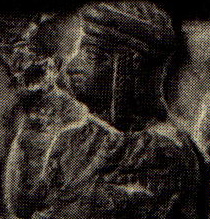 (Enheduanna, author / praiser of Inanna, daughter to Sargon & possibly Inanna, his goddess-spouse)
(Enheduanna, author / praiser of Inanna, daughter to Sargon & possibly Inanna, his goddess-spouse)
1) en-hé-du-an-na……………. En-hedu-ana
2) dumu-´sar-ru-GI……………..child of Sargon:
3) DINGIR-IGI.D[U]…………….. Ilum-pal[il]is her coiffeur
4) kinda-[ni] [(x)]
*** A new seal has been discovered with Enheduanna’s name on it.
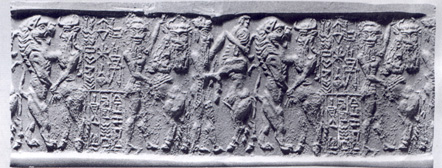 (Sargonid Period seal with Enheduana’s name listed)
(Sargonid Period seal with Enheduana’s name listed)
